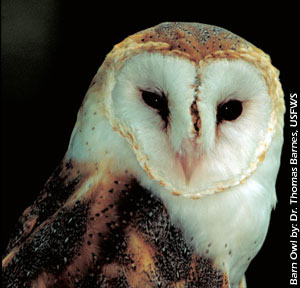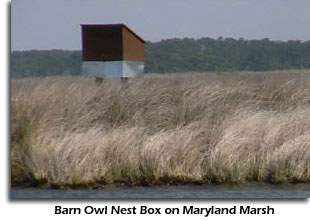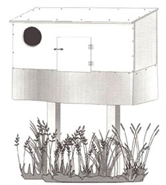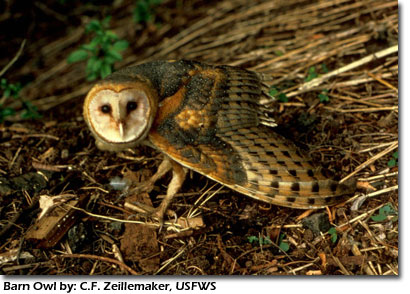The Barn Owl is one of the most celebrated species in literature, especially in folk tales. Its habit of nesting in the belfries of churches and hunting at night over graveyards has made the Barn Owl somewhat of a superstitious legend in Europe. Barn Owls can be found on every continent except Antarctica.
Their ghostly appearance, with a golden-tan back and white underside, and their vocal series of shrieks, snarls and hisses add to the birds' mystique. Local names for the Barn Owl include the "ghost owl" and the "monkey-faced owl" - named because of its expressive, heart-shaped face and dark eyes.
Unlike most bird species, Barn Owl females tend to be a bit showier than the males, sporting more spots on their chests. Studies have found that females with greater amounts of spots had less trouble with parasitic flies and possibly were more resistant to disease. Another study found that if a female's spots were covered up, then the male was less likely to feed her chicks.

Natural History
Barn Owls are year-round residents that are found throughout Maryland, especially in rural areas in the Piedmont and Coastal Plain where there are grasslands, marshes, hayfields or abandoned fields. Barn Owls can also be found in brackish and saltwater marshes. Conversely, they are rarely found in areas covered with row crops.
Barn Owls nest within easy reach of the fields where they find their favorite food - meadow voles. One pair of Barn Owls and their offspring may catch and consume as many as 3,000 rats per year. Nest sites include abandoned buildings, barns, silos, duck blinds, hollow trees, rock walls, and holes in banks and cliffs. Barn Owls lay 2-18 eggs directly on the floor of the nest site they have chosen. The eggs, incubated by the female, hatch in about 30 days. The male takes on his role after the chicks are hatched and brings food to them. About 10 weeks later, the chicks are ready to fly. Barn Owls can nest all year long, but usually do so between March and September.

Barn Owls on the Decline
Despite their widespread distribution across the State, Barn Owl occurrences have declined dramatically in Maryland. Population declines have also been observed in the Midwest as well as in other eastern states. Reasons for the decline may be due to the reductions in open grasslands preferred by Barn Owls, increased use of rodenticides and/or loss of nesting habitat. If you live on a farm and use pesticides for rodent control, then please try to avoid products that contain alphachloralose, calciferol and cholecalciferol. All three of these chemicals may cause secondary poisoning of rodent predators like owls. If you have large, open grasslands or marshes on your property, then you may want to put up nest boxes to encourage Barn Owls to visit your property.
The
Maryland Bird Conservation Partnership is collaborating with Calvert County Natural Resources Division and Maryland Department of Natural Resources on a
Maryland Farmland Raptor Program. To volunteer to help build and/or monitor nest boxes, please contact
farmlandraptors@marylandbirds.org.
How to Build a Wall-Mounted or Free-Standing Nest Box

Materials:
- 1" x 16" x 16' untreated lumber
- 1 1/2" nails
- Non-corrosive hinged cabinet lock
- 2 strong, non-corrosive door hinges
Construction:
- Mark and cut the pieces out of the lumber.
- On the front piece, make a square entrance hole, 6" x 6". Make a corresponding hole in the wall of the barn or silo. The entrance hole should be 7" from the bottom of the box.
- Use nails to assemble the box: front, bottom, back and sides. Use the hinges to attach the top to the box.
- Use the cabinet lock with a padlock through the loop to close the top down onto the box. This will allow you to open the box when cleaning it and to keep it closed from predators while the birds are nesting.
- Drill several drainage holes in the bottom of the box.
- Drill small holes in the tops of the sides for ventilation.
- Place the box on an interior crossbeam flush with a barn wall or directly on the wall itself.
- If in a barn, secure near the wall where you have cut a 6" x 6" hole.
Tips for Attracting Barn Owls
- Barn Owls are not usually urban or suburban birds, mainly because there are few large open fields in these areas. You have a chance of attracting Barn Owls if you live in a rural area with grass, hay, or abandoned fields nearby or with wet meadows or salt marsh.
- If you have a seldom used or abandoned barn or silo, check for the presence of Barn Owls by looking for two inch black pellets on the ground inside the building. These are pieces of indigestible fur and bones from the animals eaten by the owls. If you see these, you very well may have a resident Barn Owl that might nest in a Barn Owl box. Try to place your box near the area where the pellets were found.
- Place your Barn Owl box 20 to 25 feet off the ground in a covered barn or silo that is not often used.
- Clean your owl nest box once a year. Usually, January is the safest month to do this, but Barn Owls can be nesting at anytime during the year. Pigeons may try to nest in the box so be sure to remove them and their litter, as well as any pellets or other prey remains.
- Do not disturb the owls while they are nesting. Adult owls will sometimes abandon their eggs if disturbed. Be observant of any occupation of your nest box before disturbing it.
- Face a wall-mounted box away from prevailing winds.

Invite Wildlife into Your Backyard!
For Additional Information, Contact:
Sarah Witcher
Wildlife and Heritage Service
580 Taylor Ave, E-1
Annapolis, MD 21401
sarah.witcher1@maryland.gov
Phone: 410-260-8566
Acknowledgements:
- Close-up of Barn Owl, photo by Dr. Thomas Barnes, USFWS
- Barn Owl on ground, photo by C.F. Zeillemaker, USFWS